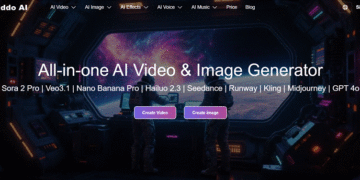Key Takeaways
- 100,000 Free AI Words for Everyone
MachineTranslation.com offers 100,000 free words of AI-powered translation to all users—no sign-up required. Registered users get a monthly refill, making it ideal for ongoing needs. - Smarter, Customizable Translations
Users can define key terminology, personalize tone and style, and even train the AI to remember their preferences over time—enhancing accuracy with each use. - Built for Individuals and Teams Alike
Whether you’re translating a single document or managing multilingual workflows at scale, it supports file uploads, segmented editing, API integration, and human review for high-stakes content.
Machine translation has come a long way in recent years, driven by rapid advancements in artificial intelligence and large language models. As global communication becomes increasingly digital, the need for accurate, efficient, and accessible translation tools is more important than ever.
In this context, MachineTranslation.com—The world’s most accurate AI translator developed by language services provider Tomedes—has taken a bold step forward. The platform now offers 100,000 free AI-translated words to all users, with no registration required. For those who do choose to register, the allowance renews each month.
This initiative stands out not just for its generosity, but for what it represents: a rethinking of how machine translation can serve a broader audience.
Rethinking Access to AI Translation
Many AI translation platforms today operate under a freemium model, offering limited access before encouraging users to upgrade for full functionality. MachineTranslation.com challenges that paradigm by providing full-feature access upfront, allowing users to explore high-volume AI translation capabilities without a financial commitment.
With 100,000 free words per user and a monthly refill for registered accounts, users can translate everything from websites and documents to marketing materials and multilingual reports. There’s no trial expiration, no surprise paywall—just access.
This approach opens the door for individuals and small teams who might otherwise hesitate to invest in translation software. It also serves as a low-risk way for larger organizations to evaluate AI translation as part of their multilingual workflows.
Smarter Translations Through Customization
While volume is important, quality and control are just as critical. MachineTranslation.com goes beyond basic machine translation by offering several tools that enhance both the output and the user experience.
One such feature is the AI Translation Agent, which prompts users with questions after the initial translation is generated. These prompts guide users to refine the tone, terminology, and style of the output. Think of it as a lightweight but effective way to bring human-level nuance into AI-generated content.
More recently, the AI Translation Agent was updated with memory capabilities for registered users. This means the system can recall previous choices, terminology preferences, and even style instructions. Over time, this memory-driven customization results in translations that are more aligned with user expectations—without requiring the same repetitive edits for every project.
Key Term Control for Specialized Content
For fields like legal, medical, or technical translation, terminology consistency is non-negotiable. This AI translation tool addresses this through a feature called Key Term Translations, which automatically identifies important terms in the source text and suggests up to three translation options for each.
Users can review these options and select the most accurate or contextually appropriate version. The selected term is then applied consistently throughout the entire translation. This function is particularly helpful in reducing post-editing time and maintaining clarity in subject-specific documents.
The tool has practical use across industries—from translating product manuals to ensuring regulatory compliance in multilingual contracts.
Enhanced Editing With Bilingual Segment View
Editing long, continuous blocks of translated text can be tedious. To make the process easier, This AI translator includes a segmented bilingual view. This interface breaks down translations into side-by-side segments—original text on the left, translated output on the right.
Users can edit individual segments, spot inconsistencies more easily, and apply changes without scrolling through entire documents. The segmented layout makes translation review more approachable, even for users without formal linguistic training.
For texts between 30 and 750 words, this feature is already available. Support for longer texts is currently in development, which will further extend its utility for large-scale translation tasks.
Built for Scale and Integration
While the platform serves casual users, it also supports more complex, enterprise-level needs. For instance, API integration allows companies to embed MachineTranslation.com’s engine into their existing systems. This is particularly useful for developers, localization managers, and content teams who need to automate or streamline high-volume translations.
There’s also an option for Human Review, which enables users to submit AI-generated translations for professional editing. This is critical for organizations that require content to meet formal or legal standards, such as in healthcare, law, or public communications. The service follows ISO 18587 standards for post-editing machine translations.
These optional upgrades reflect a hybrid philosophy: automation where it works, and human expertise where it matters most.
Language Coverage and Document Support
This AI translation tool supports over 270 languages, including several that are less commonly found on mainstream translation platforms. Recent additions include Awadhi, Betawi, Hunsrik, Hakha Chin, Romani, and Tetum—demonstrating a commitment to global accessibility.
The platform also supports a wide variety of document formats: DOCX, PDF, TXT, JPG, CSV, and XLSX, among others. Users can upload scanned PDFs or spreadsheets, and the system will extract and translate the text without the need for manual copying and pasting.
This kind of flexibility helps make the translation process faster and more seamless, whether you’re handling legal documents, academic research, or marketing assets.
Evaluating Quality Through AI Insights
One of the unique aspects is its use of AI-powered quality scoring and comparative analysis. Each translation comes with a numerical quality score and optional insights into term variations and tone differences.
Users can also view outputs from multiple translation engines side by side—a useful feature for evaluating different interpretations or levels of fluency. By showing which terms remain consistent across engines and highlighting discrepancies, the platform helps users make informed decisions about which version best meets their goals.
This feature is particularly useful for teams that need to audit or justify translation decisions, such as legal or compliance departments.
Reducing Costs, Not Quality
In many use cases, AI-generated translations are accurate enough to be used as-is. For those that require a bit more polishing, the built-in tools for glossary management, revision prompts, and segment-level editing make refinement straightforward.
When professional accuracy is non-negotiable, the Human Review option is there—but the point is that it’s an option. This flexible approach gives users the ability to balance quality and cost according to the demands of each specific project.
Final Thoughts: A Step Toward More Equitable Translation Tools
Offering 100,000 free words to every user—no sign-up required—is more than just a marketing move. It reflects a broader shift toward making language technology more inclusive and user-centric.
MachineTranslation.com isn’t the only player in the AI translation sector, but its commitment to open access, transparent quality metrics, and user-driven refinement sets it apart in meaningful ways.
For individuals and organizations looking to explore AI translation without committing to a subscription or encountering feature limitations, this platform offers a rare combination of openness and functionality.












































































